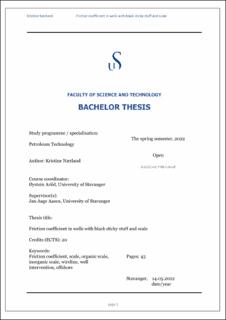| dc.contributor.advisor | Aasen, Jan Aage | |
| dc.contributor.author | Nærland, Kristine | |
| dc.date.accessioned | 2022-07-13T15:51:49Z | |
| dc.date.available | 2022-07-13T15:51:49Z | |
| dc.date.issued | 2022 | |
| dc.identifier | no.uis:inspera:108212691:50344546 | |
| dc.identifier.uri | https://hdl.handle.net/11250/3005147 | |
| dc.description.abstract | Scale buildup is a common problem in oil and gas producing wells all over the world. It gives difficulties to both the production of oil and gas, as well as well intervention operations. The buildup of scale generates more intervention work due to for example scaling of down hole safety valves and scale-buildups inside the production tubing.
Scale can be divided into two main types, organic and inorganic scale. Organic scale is present in the beginning of a reservoir’s life, while inorganic scale is present later in the reservoir’s life, when it is more mature. Waxes and asphaltenes are examples of organic scale, while carbonates and sulphates are examples of inorganic scale. Calcium carbonates, CaCO3 and BaSO4 are common types of inorganic scale in the North Sea.
This thesis focuses on finding the real coefficient of friction in an oil producer in the North Sea. It uses simulation data and real time data from an offshore operation performed in February 2022. It gives a brief introduction to the theory behind coefficient of friction, scale and black sticky stuff (BSS). It also presents wireline equipment and how it works in an offshore operation | |
| dc.description.abstract | Scale buildup is a common problem in oil and gas producing wells all over the world. It gives difficulties to both the production of oil and gas, as well as well intervention operations. The buildup of scale generates more intervention work due to for example scaling of down hole safety valves and scale-buildups inside the production tubing.
Scale can be divided into two main types, organic and inorganic scale. Organic scale is present in the beginning of a reservoir’s life, while inorganic scale is present later in the reservoir’s life, when it is more mature. Waxes and asphaltenes are examples of organic scale, while carbonates and sulphates are examples of inorganic scale. Calcium carbonates, CaCO3 and BaSO4 are common types of inorganic scale in the North Sea.
This thesis focuses on finding the real coefficient of friction in an oil producer in the North Sea. It uses simulation data and real time data from an offshore operation performed in February 2022. It gives a brief introduction to the theory behind coefficient of friction, scale and black sticky stuff (BSS). It also presents wireline equipment and how it works in an offshore operation | |
| dc.language | eng | |
| dc.publisher | uis | |
| dc.title | Friction coefficcient in wells with black sticky stuff and scale | |
| dc.type | Bachelor thesis | |
